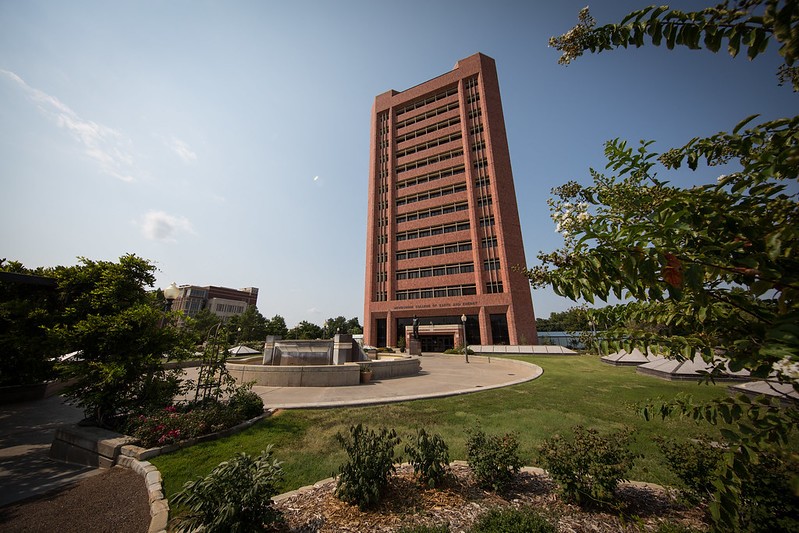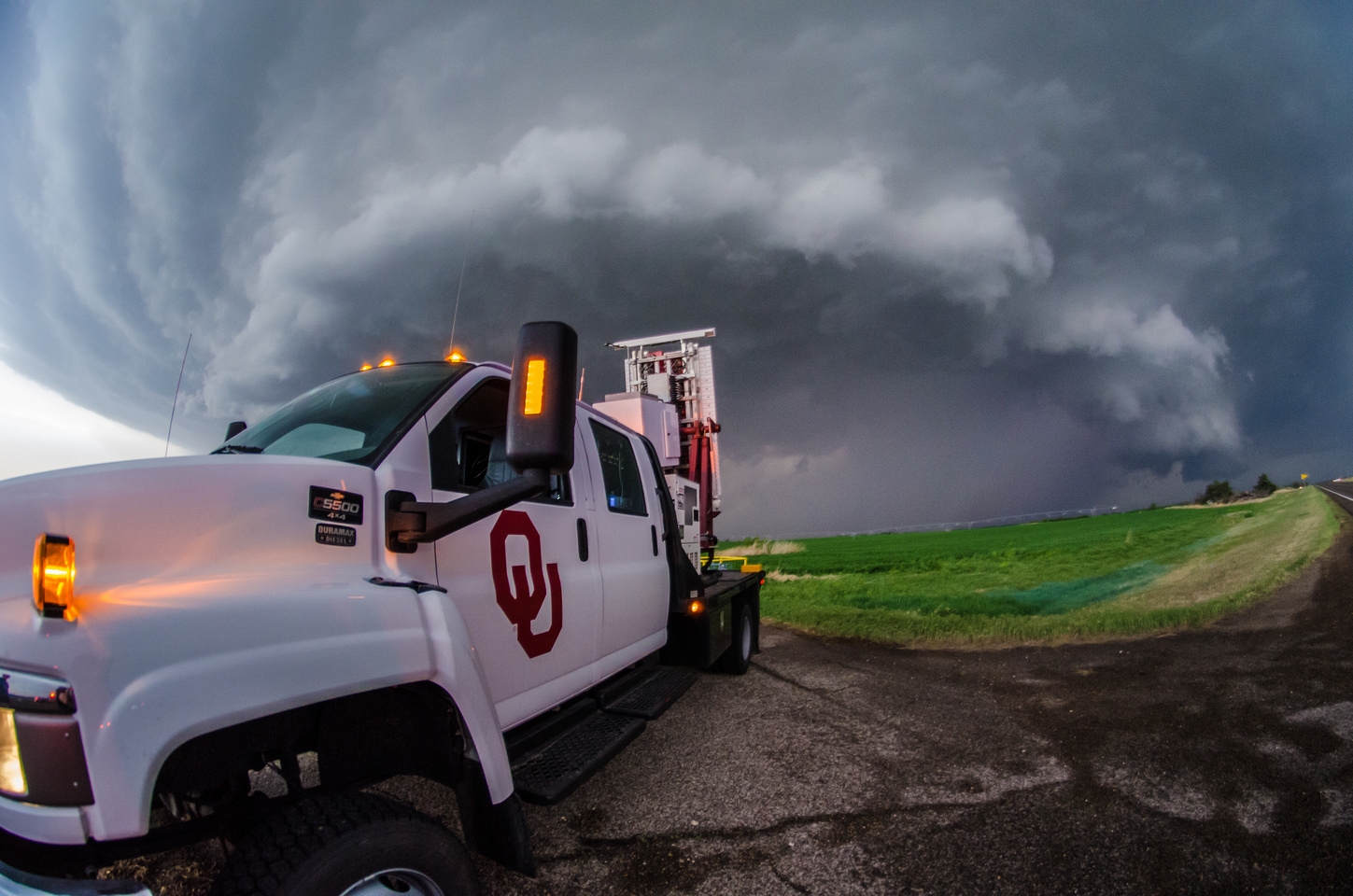The College of Atmospheric & Geographic Sciences has established more partnerships with professional agencies than any other college on the OU campus. The College consistently brings in significant amounts of annual research grant funding. These grants touch on major issues of the day, including climate, greenhouse gases, adaptation, and observational programs (including in situ, space-, and aircraft-based programs), as well as grants at the intersection of social science and physical science.
The Department of Geography and Environmental Sustainability undertakes research that pursues the goal of “Navigating Global Change and Forging Sustainable Futures.” Toward this end, we structure our research efforts around three themes: Geospatial Techniques; Climate, Environment, and Society; and the Geographies of Health and Wellbeing. The first topic encompasses a range of methods and tools to analyze and interpret spatial data, enabling the exploration, modeling, and visualization of geographic information for various applications to promote environmental sustainability and social equity. The second research cluster incorporates physical and social science to investigate the interactions among climate, the environment, and society to enhance our understanding of landscapes and the human systems shaping them with an overall goal of enhancing sustainability and fairness. The final area investigates the influences of natural and human environments on the physical, biological, and social processes that affect the burden of diseases and/or the overall quality of life in diverse geographic settings.


OU Aviation structures our research efforts around five themes: Human Factors, Human Performance, Human-Machine Learning, UAS/AAM Integration, and the Safety of the National Airspace System. Since 2016, OU Aviation has served as the Technical Lead of the Federal Aviation Administration's Center of Excellence for Technical Training and Human Performance. In this role, OU is responsible for cultivating and onboarding FAA funders, developing and managing multi-institution research projects, overseeing technical and fiscal reporting, and disseminating research findings for fifteen core institutions and over fifty industry partners. The FAA COE TTHP research consortium is dedicated to advancing the technical training and improving the human performance of pilots, air traffic controllers, maintenance technicians, safety inspectors, UAS operators, engineers, and human factors specialists. These studies include the use of mobile learning applications for skill-based training; developing and modeling risk management procedures for UAS operations at airport facilities; and developing training recommendations to assist the FAA workforce with the safe integration of UAS/AAM vehicles in the National Airspace System.
The School of Meteorology and the whole National Weather Center is home to experts who conduct research across the atmospheric sciences including weather, climate, and the interactions between them and with society. The School’s long-term foundation and expertise in severe storms and radar meteorology has been recognized as world-leading. Recent expansion and diversification of the research portfolio of the School has occurred across the atmospheric sciences with an emphasis on prediction of high impact weather, which includes severe storms and extreme weather as well as research on air quality and atmospheric composition. Research areas span spatial scales from turbulence in the boundary layer to sub-seasonal to seasonal forecasting and climate variability and change and span the globe from tropical to polar meteorology. The School of Meteorology continues to be a leader in research to operations and improving weather and climate predictions using numerical weather prediction, artificial intelligence, and collaborations with federal partners in the National Weather Center.

The ARRC’s mission is to enhance safety, security, environmental quality, and economic prosperity through interdisciplinary research and development of innovative radar solutions to a wide range of societal challenges. This confluence of science and engineering in radar and applied electromagnetics empowers research, enhances collaboration, inspires discovery, and improves lives. The ARRC has always focused on developing cutting-edge radar technology for scientific discovery and has now expanded into many more applications of radar and applied electromagnetics.
CAPS's mission is to develop and demonstrate techniques for the numerical analysis and prediction of high-impact local weather and environmental conditions, with emphasis on the assimilation of observations from Doppler radars and other advanced in-situ and remote sensing systems.
CAPS strives to be the world leader in convective-scale data assimilation and numerical weather prediction, providing a venue for exploring bold new ideas, attracting the best scientists and students, and facilitating the transfer of knowledge and technology to academia, government and industry.
The Cooperative Institute for Severe and High-Impact Weather Research and Operations (CIWRO) is the largest research center at the University of Oklahoma. CIWRO was established in 2021, and extends cooperative programs between the National Oceanic and Atmospheric Administration (NOAA) and OU that have existed continually since 1978. CIWRO connects the scientific and technical resources of OU and NOAA with the goal of improving the basic understanding of weather and transitioning that understanding to operations to produce better forecasts that save lives and property.
The Center for Spatial Analysis (CSA) is a multidisciplinary research center housed on the OU-Norman Research campus, specializing in applied geospatial technology research and development. We focus on providing services to:
The COE TTHP includes 26 academic members and 45+ industry partners responsible for conducting research and development on technical training for air traffic controllers, aviation safety inspectors, engineers, pilots, and technicians. The COE also examines human factors issues such as changes in learner expectations and best practices for innovative technologies in training a new generation of learners.
OCS provides climatological services to the people of Oklahoma, conducts research on the impacts of climate on human activities, and serves as a support facility for the State Climatologist. OCS has a legislative mandate to acquire, process, and disseminate climate and weather data and information for use by the state's citizens.
The Oklahoma Mesonet consists of over 100 automated observing stations that continuously monitor numerous important weather and soil variables. The Oklahoma Mesonet Program is administered jointly by the University of Oklahoma and Oklahoma State University.
The South Central CASC is a partnership between the US Geological Survey and a consortium of seven member institutions consisting of the University of Oklahoma, Texas Tech University, Louisiana State University, the Chickasaw Nation, the Choctaw Nation of Oklahoma, Oklahoma State University, and the University of New Mexico. The consortium has broad expertise in the physical, biological, natural, and social sciences to address impacts of climate change on land, water, fish and wildlife, ocean, coastal, and cultural resources. The NCASC and regional CASCs work with natural and cultural resource managers to gather the scientific information and build the tools needed to help fish, wildlife and ecosystems adapt to the impacts of climate change.
The Southern Climate Impacts Planning Program (SCIPP) is a South Central United States focused climate hazards and research program whose mission is to assist organizations with making decisions that build resilience by collaboratively producing research, tools, and knowledge that reduce weather and climate risks and impacts across the South Central United States.
By integrating physical and social science knowledge into the hazard planning process, the SCIPP Team focuses on understanding decision processes, advancing knowledge of regional climate-related threats, synthesizing existing knowledge, and collaboratively identifying viable solutions. Through collaboration with regional stakeholders, SCIPP seeks to improve communities’ ability to plan for, absorb, recover from and successfully adapt to adverse effects of extreme weather events and climate change.

February 12, 2025
A new study published in Nature Communications Earth and Environment gives possible insight into the underprediction of sea ice depletion and the formation of Arctic cyclones. The study could lead to more accurate weather and climate models and better forecasting of Arctic cyclones.